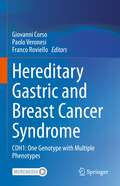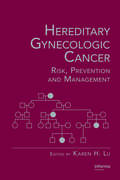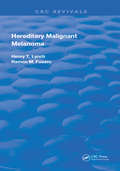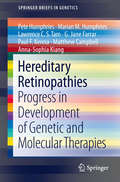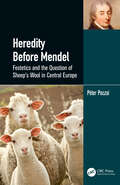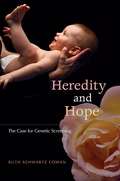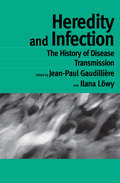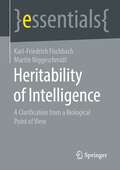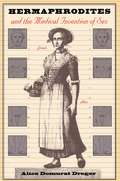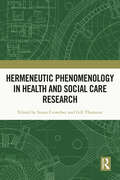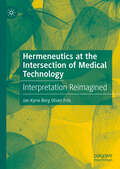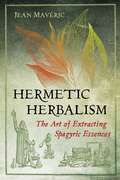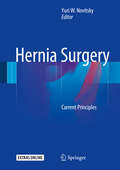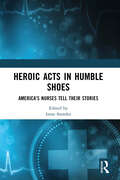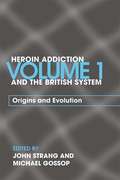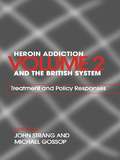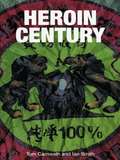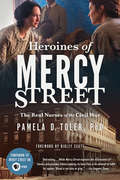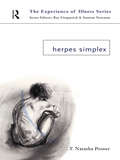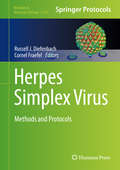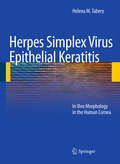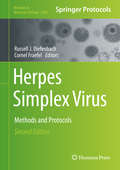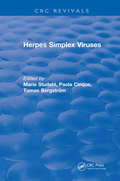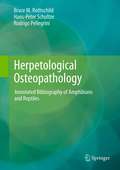- Table View
- List View
Hereditary Gastric and Breast Cancer Syndrome: CDH1: One Genotype with Multiple Phenotypes
by Franco Roviello Giovanni Corso Paolo VeronesiIn this book the editors and authors provide a comprehensive overview on basic research and clinical aspects of hereditary breast and gastric tumors. In particular, this updated editorial work aims to suggest guidelines for the clinical management of patients with hereditary diffuse gastric and lobular breast cancer. Special attention is given to E-cadherin (CDH1 gene) germline mutations, genetic screening approaches, the underlying molecular mechanisms and pathological and microscopic features. In addition, the book aims to define clinical criteria for genetic screening, and highlights current surgical treatment and clinical approaches for asymptomatic mutation carriers. Other inherited predispositions involving gastric and breast carcinoma are discussed as well. Divided into eight sections, the book starts by providing an epidemiological overview of gastric and breast cancers, followed by a section dealing with new descriptions of genetic pathways in hereditary cancer predispositions. The third section focuses on pathological features of the diseases, in an effort to bridge the gap between discovery and cancer therapy development. Subsequent sections of the book are dedicated to endoscopy and breast imaging, as well as risk-reducing surgeries to curb the risk of developing cancer. The sixth section focuses on the generation of ideas for the identification of targets and novel treatment strategies. Finally, in the seventh section the authors share the story of two patients and their experiences with the diagnosis and treatment of hereditary cancer.This multidisciplinary book brings together multiple disciplines in science and technology; specifically, medicine, surgery and biology. The majority of authors are members of the International Gastric Cancer Linkage Consortium (IGCLC) and of the European Cancer Prevention Organization (EJCPO), with relevant experience in this context. Offering in-depth insights into hereditary cancers, this book represents essential reading for students, researchers, and specialists who want to extend their knowledge on hereditary gastric and breast cancers.
Hereditary Gynecologic Cancer: Risk, Prevention and Management
by Karen H. LuHereditary Gynecologic Cancer: Risk, Prevention and Management fills the need that exists for a book addressing highly relevant clinical issues associated with the new field of hereditary gynecologic cancers. Written with the clinician in mind, the authors will cover a broad range of topics, beginning with an overview discussing clinical relevance
Hereditary Malignant Melanoma (Routledge Revivals)
by Henry T. Lynch Ramon M. FusaroFirst published in 1991: The book focuses only on hereditary malignant melanoma. The epidemic of cutaneous melanoma which is now occurring in the sun belt areas of the world is due partly to a susceptible subgroup of Caucasians who have immigrated there.
Hereditary Retinopathies
by Matthew Campbell G. Jane Farrar Lawrence C. Tam Marian M. Humphries Pete Humphries Anna-Sophia Kiang Paul F. KennaThe hereditary retinopathy, retinitis pigmentosa (RP), which affects 1 in 3,500 people worldwide, is the most common cause of registered visual handicap among those of the working age in developed countries. RP is a highly variable disorder where patients may develop symptomatic visual loss in early childhood, while others may remain asymptomatic until mid-adulthood. Most cases of RP segregate in autosomal dominant, recessive or X-linked recessive modes, with approximately 41 genes being implicated in disease pathology to date (RetNet). The extensive genetic heterogeneity associated with autosomal dominant RP (adRP) is an undisputed hindrance to the development of genetically based therapeutics.
Heredity Before Mendel: Festetics and the Question of Sheep's Wool in Central Europe
by Péter PoczaiThe history of Science is replete with untold stories and this book is one of these accounts. The author shares a narrative of heredity, an active topic of inquiry long before Gregor Mendel – the father of genetics – planted his peas. One such interlude unfolded in Mendel’s home city and involved the sheep breeder, Imre Festetics. He sought to improve wool and proposed important rules of heredity. Unfortunately, aspects of wool quality, now known to be polygenic, complicate interpretations of the work of Festetics and explain why it is neglected. The forebearers of Mendel never get the credit they deserve. Heredity Before Mendel resurrects Festetics, the grandfather of heredity. Key Features 1) Documents a vibrant community of scholars interested in heredity before Mendel 2) Highlights the work of Imre Festetics, the forgotten grandfather of genetics 3) Desribes political repression which stifled the nascent foundation of heredity research 4) Emphasizes the role sheep and wool played as the first model system of genetics 5) Challenges19th century taboos in Moravia leading to malicious rumors about the inbred royal House of Austria (Habsburgs).
Heredity and Hope: The Case for Genetic Screening
by Ruth Schwartz CowanThe secrets locked in our genes are being revealed, and we find ourselves both enthused and frightened about what that portends. We look forward to curing disease and alleviating suffering--for our children as well as for ourselves--but we also worry about delving too deeply into the double helix. Abuses perpetrated by eugenicists--from involuntary sterilization to murder--continue to taint our feelings about genetic screening. Yet, as Ruth Schwartz Cowan reveals, modern genetic screening has been practiced since 1960, benefiting millions of women and children all over the world. She persuasively argues that new forms of screening--prenatal, newborn, and carrier testing--are both morally right and politically acceptable. Medical genetics, built on the desire of parents and physicians to reduce suffering and increase personal freedom, not on the desire to "improve the human race," is in fact an entirely different enterprise from eugenics. Cowan's narrative moves from an account of the interwoven histories of genetics and eugenics in the first half of the twentieth century, to the development of new forms of genetic screening after mid-century. It includes illuminating chapters on the often misunderstood testing programs for sickle cell anemia, and on the world's only mandated premarital screening programs, both of them on the island of Cyprus. Neither minimizing the difficulty of the choices that modern genetics has created for us nor fearing them, Cowan bravely and compassionately argues that we can improve the quality of our own lives and the lives of our children by using the modern science and technology of genetic screening responsibly.
Heredity and Infection: The History of Disease Transmission (Routledge Studies in the History of Science, Technology and Medicine)
by Jean-Paul Gaudillière Ilana LöwyIdeas about the transmission of disease have long formed the core of modern biology and medicine. Heredity and Infection examines their development over the last century. Two scientific revolutions - the bacteriological revolution of the 1890s and the genetic revolution at the start of the twentieth century - acted as the catalysts of major change in our understanding of the causes of illness. As well as being great scientific achievements, these were social and political watersheds that reconfigured the medical and administrative means of intervention. By establishing a clear distinction between transmission by infection and genetic transmission, this shift was instrumental in separating hygiene from eugenism. The authors argue that the popular perception of such a sharp divide stabilized only after 1945 when the use of antibiotics to end epidemics became commonplace. For health professionals the separation has never become an absolute one, and the book examines the various blends of heredity and infection that have preoccupied biology, medicine and the social sciences. Heredity and Infection recontructs the changing epidemiology of such historically important pathologies as tuberculosis , cancer and AIDS. In doing so, it demonstrates the role of experimental models, medical practices and cultural images in the making of contemporary biochemical knowledge.
Heritability of Intelligence: A Clarification From a Biological Point of View (essentials)
by Karl-Friedrich Fischbach Martin NiggeschmidtIs intelligence heritable? Karl-Friedrich Fischbach and Martin Niggeschmidt show that "heritability" means something different in biological terminology than in everyday language - which almost inevitably leads to misinterpretations. They explain why twin studies are controversial - and why genetic predictions of IQ and "educational attainment" must be treated with skepticism. This book is a translation of the original German 2nd edition Erblichkeit der Intelligenz by Karl-Friedrich Fischbach & Martin Niggeschmidt, published by Springer Fachmedien Wiesbaden GmbH, part of Springer Nature in 2019. The translation was done with the help of artificial intelligence (machine translation by the service DeepL.com). A subsequent human revision was done primarily in terms of content, so that the book will read stylistically differently from a conventional translation. Springer Nature works continuously to further the development of tools for the production of books and on the related technologies to support the authors.The Authors:Prof. Dr. Karl-Friedrich Fischbach is a developmental biologist and neurogeneticist. He was professor of biophysics and molecular biology at the University of Freiburg from 1985 to 2013, including two years as executive director of the Institute of Biology III. Martin Niggeschmidt is an editor in Hamburg.
Hermaphrodites and the Medical Invention of Sex
by Alice Domurat DregerPunctuated with remarkable case studies, this book explores extraordinary encounters between hermaphrodites--people born with "ambiguous" sexual anatomy--and the medical and scientific professionals who grappled with them. Alice Dreger focuses on events in France and Britain in the late nineteenth century, a moment of great tension for questions of sex roles. While feminists, homosexuals, and anthropological explorers openly questioned the natures and purposes of the two sexes, anatomical hermaphrodites suggested a deeper question: just how many human sexes are there? Ultimately hermaphrodites led doctors and scientists to another surprisingly difficult question: what is sex, really? Hermaphrodites and the Medical Invention of Sex takes us inside the doctors' chambers to see how and why medical and scientific men constructed sex, gender, and sexuality as they did, and especially how the material conformation of hermaphroditic bodies--when combined with social exigencies--forced peculiar constructions. Throughout the book Dreger indicates how this history can help us to understand present-day conceptualizations of sex, gender, and sexuality. This leads to an epilogue, where the author discusses and questions the protocols employed today in the treatment of intersexuals (people born hermaphroditic). Given the history she has recounted, should these protocols be reconsidered and revised? A meticulously researched account of a fascinating problem in the history of medicine, this book will compel the attention of historians, physicians, medical ethicists, intersexuals themselves, and anyone interested in the meanings and foundations of sexual identity.
Hermeneutic Phenomenology in Health and Social Care Research
by Susan Crowther Gill ThomsonThis book explores how, why, and when hermeneutic phenomenology can be used as methodology in health and social research. Providing actual examples of doing robust hermeneutic phenomenology and a focus on praxis, the book demonstrates how philosophical or theoretical notions can inform, enrich and enhance our research projects. The chapters offer examples of many different research designs and interpretive decisions in order to illustrate the unbounded and creative nature of this type of inquiry, whilst also demonstrating the trustworthiness of the scientific processes adopted. The chapter authors invite the reader on a unique journey that highlights how they made individual and tailored decisions throughout their projects, emphasising the challenges and joys they encountered. This book is a valuable resource for all students and academics who wish to explore the meaningfulness of human lived experiences across the multitude of phenomena in health and social care.
Hermeneutics at the Intersection of Medical Technology: Interpretation Reimagined
by Jan Kyrre FriisThis book explores the crucial role of interpretation in medical radiology and beyond, emphasizing its pervasive influence on medical knowledge. Friis examines radiological analysis through hermeneutics, cognition, and visual perception studies. He argues that interpretation is inherently embodied and essential to human action, particularly in radiology, where technology extends vision beyond the human eye&’s limits. Yet, interpretation varies among radiologists. Can it be too relative, shaped by subjective factors irrelevant to the task? Attempts to eliminate cognitive bias through psychophysical and cognitivist approaches have failed. Interpretation is an active, context-dependent process, inseparable from human experience. Friis contends that the only solution is to expand cognitive reach through collaborative interpretative practices, integrating diverse perspectives. Radiology, like all medical fields, benefits from shared expertise, where multiple viewpoints refine diagnostic accuracy and mitigate individual bias. By fostering structured cooperation among radiologists, clinicians, interpretative reliability can be strengthened. The key is not to eliminate subjectivity but to harness it constructively through interdisciplinary dialogue, collective reasoning, and continuous knowledge exchange.
Hermetic Herbalism: The Art of Extracting Spagyric Essences
by Jean MavéricA never-before-translated occult classic that brings the science of herbal medicine back to its Hermetic roots • Includes a large collection of recipes for spagyric medicines and quintessences, with detailed step-by-step instructions, adapted from celebrated spagyrists such as Paracelsus, Pseudo-Lull, Philipp Ulstad, and Nicaise Le Fèvre • Provides botanical and medicinal classifications of over 600 plant species along with their astral natures, elemental qualities, and planetary and zodiacal signatures • Explores advanced methods and techniques and shares the author&’s secret formula for a universal circulatum First published in French in 1911, this practical guide to the art of spagyrics begins by outlining the ancient yet often forgotten Hermetic foundations of herbalism. Author Jean Mavéric provides botanical and medicinal classifications of over 600 plant species along with an in-depth study of their astral natures, elemental qualities, and planetary and zodiacal signatures as well as practical advice on the appropriate times to harvest plants and administer herbal remedies and quintessences. Reviewing the general principles and procedures of premodern chemistry, Mavéric then explores the secret doctrines and operations of the spagyric art. He offers a large collection of recipes for spagyric herbal preparations adapted from celebrated spagyrists such as Paracelsus, Pseudo-Lull, Philipp Ulstad, Jan Baptist van Helmont, Oswald Croll, and Nicaise Le Fèvre, providing detailed step-by-step instructions for a veritable pharmacopeia of spagyric extracts, tinctures, elixirs, liquors, oils, unguents, salts, aquae vitae, and quintessences. Mavéric also shares his intricate theory of astral medicine and advocates a seasonal &“Hermetic diet&” designed to keep the humors of the body in equilibrium and prevent the onset of illness. In the final section of the book, Mavéric focuses on the more advanced methods and techniques of Paracelsus, Helmont, and George Starkey, unraveling the mysteries of manufacturing alkalis, alkahests, and menstrua and divulging his own secret formula for a universal circulatum. Available now for the first time in English, this occult classic unveils the art of extracting spagyric essences to a modern audience while also bringing the science of herbal medicine back to its Hermetic roots.
Hernia Surgery
by Yuri W. NovitskyThis textbook provides a state-of-the-art reference in the rapidly changing field of hernia surgery. With contributions by key opinion leaders in the field, this book describes the latest trends and detailed technical modifications for both routine and complex hernias. The reader will gain unique insights into robotic and laparoscopic repairs, anterior and posterior component separations, reconstructions in the setting of contamination, enterocutaneous fistulas and loss of abdominal domain. Important contributions from key reconstructive plastic surgeons detail modern trends on how to deal with complex skin and soft tissue challenges. The textbook provides unparalleled step-by-step instructions to perform both routine and complex repairs by incredible illustrations, intra-operative color photographs and a unique video collection of procedures performed by today's top hernia surgeons. As a comprehensive and most up-to-date reference to modern treatment algorithms, trends in prosthetic science and technique selections,Hernia Surgery: Current Principles will be an invaluable resource to all residents and practicing general, plastic, and trauma surgeons to help them succeed in the field of Hernia surgery.
Heroic Acts in Humble Shoes: America's Nurses Tell Their Stories
by Irene StemlerThey are compassionate voices, they are dedicated professionals, they are critical players in the health care system with worn pairs of shoes that have miles of stories to tell. They are America’s nurses.Heroic Acts in Humble Shoes: America’s Nurses Tell Their Stories is more than just a quick glance into the trials, tribulations, joys and rewards of nursing. It is a gateway to understanding what today’s nurses are challenged with everyday. Irene Stemler, RN, BSN, goes beyond the research and gives a voice to the millions of nurses who directly or indirectly make a difference in the lives of patients. Each story opens with a photograph of the nurse’s shoes and offers a unique, passionate, personal, and sometimes controversial perspective on nursing in today’s health care environment. Inside you’ll find: • Over 40 interview-style stories • Each story accompanied by a photo of the featured nurse’s shoes • Stories that reflect the breadth and diversity of today’s nursing practice Heroic Acts in Humble Shoes also looks to be a springboard for spirited discussion about the future of nursing. When nurses read these reflections of the daily battle to provide quality health care to ordinary people, they are encouraged to act, taking a leadership position in transforming their profession and nurses’ role in health care delivery as a whole.Do you consider your work to be heroic? The often surprising answer to this question makes Heroic Acts in Humble Shoes: America’s Nurses Tell Their Stories a must-read for all nurses across the U.S. and those who know them.
Heroin Addiction and The British System: Volume I Origins and Evolution
by John Strang Michael GossopThe British system of dealing with drug addiction is notable for its flexibility and its capacity to adapt to changing circumstances. Because of this it has attracted considerable international interest, although it is rarely fully understood or accurately represented.Presenting a comprehensive account of the development of policies and treatments, Heroin Addiction brings together the perspectives of policy makers, practitioners and social commentators. The book contributes to a proper understanding of how policy and practice has evolved so that lessons for future policy and practice may be identified.Volume II of Heroin Addiction charts the development and use of treatment and policy responses in the UK, highlighting the limitations of these approaches as well as their achievements. It is a unique source of reference for students, researchers, healthcare professionals and drug agencies both in the UK and overseas.
Heroin Addiction and The British System: Volume II Treatment & Policy Responses
by John Strang Michael GossopThe British system of dealing with drug addiction is notable for its flexibility and its capacity to adapt to changing circumstances. Because of this it has attracted considerable international interest, although it is rarely fully understood or accurately represented.Presenting a comprehensive account of the development of policies and treatments, Heroin Addiction brings together the perspectives of policy makers, practitioners and social commentators. The book contributes to a proper understanding of how policy and practice has evolved so that lessons for future policy and practice may be identified.Volume II of Heroin Addiction charts the development and use of treatment and policy responses in the UK, highlighting the limitations of these approaches as well as their achievements. It is a unique source of reference for students, researchers, healthcare professionals and drug agencies both in the UK and overseas.
Heroin Century
by Ian Smith Tom CarnwathHeroin is a drug that myths are made of. Whether smuggled in the stomach of a camel or used as the ultimate symbol of lifestyle chic, no drug has been more argued over and legislated against, no drug has been more subject to misinformation and moral panic.Heroin Century sets the record straight. It contains a wealth of historical and medical information about this drug which made its first appearance as a miracle medicine over a hundred years ago and makes recommendations for its future in the twenty-first century. Evidence shows that heroin is dangerous principally because it is illegal. The authors argue that a more relaxed relationship between society and the drug would benefit both the economy and public health and safely.Individual chapters describe the history of heroin production; the makeup of heroin and evolving methods of use; the spread of heroin and international efforts at control; typical "career" patterns of users, ranging from occasional recreational use to destructive dependence; the subjective experience of taking heroin; the association between heroin and crime; the use of heroin in medicine and its effects on physical health; the history of the treatment of heroin dependence; and likely changes in heroin use in the future. The authors have drawn on literary and artistic sources as well as the large pool of scientific literature to compile a comprehensive and fascinating account of this world-changing drug.Heroin Century makes available a wealth of information about the history, chemistry, pharmacology and medical aspects of heroin in a form accessible to anyone who wishes to participate in the contemporary debate bout society's attitude to drugs.
Heroines of Mercy Street: The Real Nurses Of The Civil War
by Pamela D. TolerThe true stories of the real nurses on the PBS show Mercy Street The nurses of the Civil War ushered in a new era for medicine in the midst of tremendous hardship. While the country was at war, these women not only learned to advocate and care for patients in hostile settings, saved countless lives, and changed the profession forever, they regularly fell ill with no one to nurse them in return, seethed in anger at the indifference and inefficiency that left wounded men on the battlefield without care, and all too often mourned for those they could not rescue. Heroines of Mercy Street tells the true stories of the nurses at Mansion House, the Alexandria, Virginia, hotel turned wartime hospital and setting for the PBS show Mercy Street. Women like Dorothea Dix, Mary Phinney, Anne Reading, and more rushed to be of service to their country during the war, meeting challenges that would discourage less determined souls every step of the way. They saw casualties on a scale Americans had never seen before; diseases like typhoid and dysentery were rampant; and working conditions-both physically and emotionally--were abysmal.Drawing on the diaries, letters, and books written by these nursing pioneers, Pamela D. Toler, PhD, has written a fascinating portrait of true heroines, shining a light on their personal contributions during one of our country's most turbulent periods.
Herpes Simplex
by T. Natasha PosnerThough medically minor and very common, herpes simplex is a condition which is capable of causing considerable distress, for psychological and social as much as physical reasons. Herpes Simplex contrasts the image of the condition presented in the media with the medical and epidemiological evidence, and discusses ways in which the distress associated with the condition can be alleviated.The first part of the book examines the impact of diagnosis and then explains the roles of accurate information and empathic support, medical treatment and support groups in learning to live with recurrent symptoms. Other chapters use the experiences of people with the condition in different parts of their bodies to illustrate how the meaning of herpes simplex and response to the symptoms alters in association with life changes. The final chapters review psychosocial research, discuss the importance of the Herpes Viruses Association in acquiring a store of knowledge about people's experiences, and highlight the significance of herpes simplex as a public health problem.Herpes Simplex demonstrates the importance of a biopsychosocial approach. It will be invaluable to doctors, nurses and other health professionals, as well as to people troubled by the condition.
Herpes Simplex Virus
by Russell J. Diefenbach Cornel FraefelHerpes Simplex Virus: Methods and Protocols provides a wide collection of protocols employed in various levels of herpes virus research, including basic protocols on growing viruses in cell culture and cloning, manipulating and preparing viral DNA. Other chapters describe approaches to design and apply HSV-1 vectors for vaccination, cancer and gene therapy or to study specific aspects of HSV-1 biology such as latency, intracellular transport and protein-protein interaction. Procedures for structural analyses, microscopy, proteomics and testing of antivirals are included as well. Written in the highly successful Methods in Molecular Biology series format, chapters include introductions to their respective topics, lists of the necessary materials and reagents, step-by-step, readily reproducible laboratory protocols and tips on troubleshooting and avoiding known pitfalls. Practical and authoritative, Herpes Simplex Virus: Methods and Protocols will aid new researchers in the field of herpes virology as well as those experienced investigators wishing to embark on new techniques.
Herpes Simplex Virus Epithelial Keratitis
by Helena M. TaberyThis book on Herpes Simplex Virus Epithelial Keratitis shows a kind of 'living histology', revealing both morphological and dynamic features of the disease, and explaining mechanisms behind them. It offers great insights helpful for the differential diagnostics and the recognition of less known variants as well as of complications. It is also highly useful for the follow-up of treatment results and the differentiation between an active infection and sequelae. Thus, this book will be an invaluable aid for ophthalmologists and researchers working with ocular surface diseases.
Herpes Simplex Virus: Methods and Protocols (Methods in Molecular Biology #2060)
by Russell J. Diefenbach Cornel FraefelThis second edition volume expands on the previous edition with a discussion of new and updated methods used to study the Herpes Simplex Virus (HSV), along with a look at the latest developing technologies such as next generation sequencing, CRISPR/Cas9 engineering, and the use of BioID to identify protein-protein interactions. Chapters cover topics such as the biology, life cycle, and current state of antiviral and vaccine development for HSV-1; protocols on growing viruses in cell culture and manipulating viral DNA; design and application of HSV-1 vectors for cancer- and gene-therapy; and structural analyses, microscopy, proteomics, and testing of antivirals. Written in the highly successful Methods in Molecular Biology series format, chapters include introductions to their respective topics, lists of the necessary materials and reagents, step-by-step, readily reproducible laboratory protocols, and tips on troubleshooting and avoiding known pitfalls. Cutting-edge and comprehensive, Herpes Simplex Virus: Methods and Protocols, Second Edition is a valuable resource for immunologists, and molecular and cell biologists. This book will also be useful for researchers who wish to initiate molecular and/or cellular-based approaches to study HSV.
Herpes Simplex Viruses (CRC Press Revivals)
by Marie Studahl Paola Cinque Tomas BergströmStudying the epidemiology, identification, pathogenesis and clinical features of diseases associated with herpes simplex viruses, this important reference evaluates the latest treatment regimens, mechanisms of immune response and evasion, and research related to vaccines for the prevention and reduction of HSV outbreaks. Covering the basic virology relevant to the understanding of disease manifestations, Herpes Simplex Viruses analyzes: the evolution of HSV infections recent clinical trials using new and emerging pharmaceuticals, as well as new treatments for HSV prognoses and management schemes for different disease manifestations of HSV well-known diseases such as gingivostomatitis and recurrent labial infection, HSV infections of the skin, acute and recurrent genital infection, and ocular infection diseases recently associated with HSV such as paresis of the facial nerve.
Herpetological Osteopathology
by Bruce M. Rothschild Hans-Peter Schultze Rodrigo PellegriniAs scientific analysis of testable hypotheses has replaced the speculative approach to study of bone disease in recent and fossil amphibians and reptiles, the field has advanced from simply reporting observations to analyzing their implications. This process is predicated upon a reproducible data base which explains/diagnoses the nature of bony alterations and a secure review of the literature. Thereby hangs the rub. The herpetological literature are difficult to access (let alone read) and are scattered through many prominent and eclectic journals and in the lay literature. While older diagnoses often have not stood the test of time, the clarity of report descriptions usually allows confident identification of the underlying pathology.
Hers For One Night Only?
by Carol MarinelliA woman worth breaking his rules for?After a traumatic day at work, pediatrician Dominic Mansfield arrives at a colleague's party craving escape. Emotionally vulnerable isn't his usual type, but the shadows in nurse Bridgette's eyes intrigue him. Dominic's flings never last more than one night, no matter how hot, yet the next day he finds himself knocking on Bridgette's door-and hears the sound of a crying baby!
